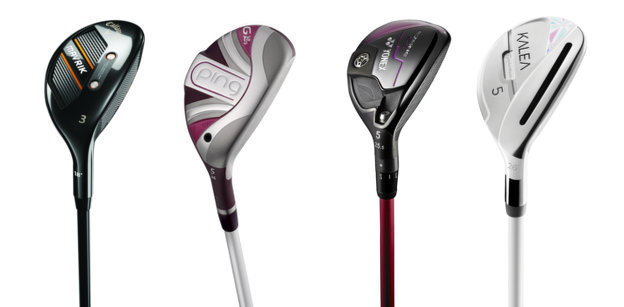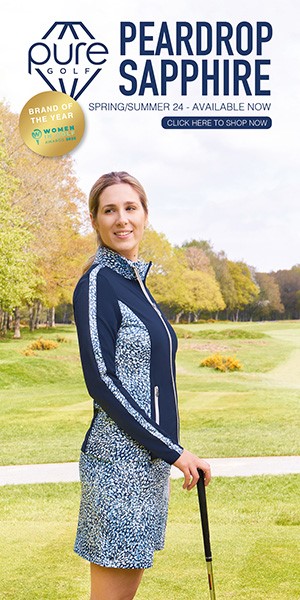The hybrid, utility club or rescue, as it's also known, is invaluable. The fact that it's known by so many names illustrates its versatility. Carly Frost offers her opinion on this useful club.

By Carly Frost
The hybrid, utility club or rescue, as it is also known, is invaluable. The very fact that it is known by so many names illustrates its versatility. Carly Frost offers her expert opinion on this useful club.
Hybrids vs Irons
The hybrid first burst onto the golfing scene more than two decades ago (some of you may remember the first Cobra ‘baffler’) and in doing so transformed the game as we know it. I certainly benefited enormously from its introduction. The endless struggle of trying to launch long irons now seems like a lifetime ago.
The longest iron I now carry is a 5-iron, I even replaced my old 7 and 5-woods with hybrids. I use 2, 3 and 4-hybrids and I do this because the hybrids give me far greater shot-making creativity in all areas of the game. I nearly always choose to use a hybrid when the ball is sat down in the rough. I can use them to recover out of heather, play them from fairway bunkers, I love to hit them off the tee to find the fairway on tight driving holes with accuracy, and they are brilliant into longer par-3s, as they fly higher and land softly.
The hybrid can be a brilliant ‘get out of jail’ club for many scenarios, even when the ball is sat down in a divot. It’s also a handy tool to play a clever little chip-and-run shot, like a putt from long range around the greens.
So what do you lose out on by removing your irons? Very little I believe. Unless you are a perfect ball striker who loves the purity of an iron, you are essentially better off with hybrids. Irons are smaller, harder to hit and less versatile. The soft metal of an iron, especially those forged, give a much more responsive feel, and the smaller clubhead shape and size does allow you to shape shots and conjure up draws and fades with bigger ball flight movement. But I guarantee that with practice you can still invent these recovery shots with a hybrid, and you’ll have far more confidence doing it.
Hybrids vs Fairway Woods
One question that I get asked a lot is: "What’s the difference between a 21-degree hybrid and a 21-degree fairway wood?"
The answer lies in the clubhead design. A fairway wood is shaped to sweep the ball away off tighter turf. As such, it works best for ladies with a shallow angle of attack and won’t work so well for golfers with a steeper swing action.
The hybrid, in contrast, is a more versatile club, that’s primarily designed to be used more like an iron with a downward hitting action, but can equally sweep the ball away due to its clever sole design. The hybrid won’t hit it the ball as far as the bigger headed fairway wood, but it will give you greater shot-making creativity. The hybrid has a deeper clubface design which also makes it easy to use off the tee on par-3s, whereas the fairway wood may just sneak it onto the green on longer ones.
How to Choose Your set Make-up?
It’s really all about matching your set of clubs to your unique golfing DNA. But who truly knows that? The one piece of advice I will give you when choosing your set make-up is to get professionally custom-fitted by an expert. This is not just something that will benefit the better player, it is truly essential for all standards of golfer who want to enjoy the game and play better. Do you know your swing speed? How do you know what to pick from the huge array of shafts and lofts? Just a couple of the questions that an expert can address.
Irons, Hybrids, Fairway Woods or a Combination of Them all?
When it comes to choosing from irons, hybrids and fairway woods you have to start by understanding what type of swing action you have. You need to know whether you are naturally a sweeper of the ball that picks it cleanly off the turf with little to no divot on a shallow angle of attack, or if you are more of a divot taker - someone who hits down steeper with a descending blow. A fairway wood with the shallow clubhead profile and larger, flatter sole design will work well for a sweeper of the ball. Whereas if you tend to hit down on the ball and take divots, then you will probably benefit from the superior performance of a hybrid.
The area of the bag where irons are more effective is the shorter clubs when you are looking to achieve spin on the ball. The key is to understand how to combine the two. Where do you need spin control and where is forgiveness and distance more paramount? The modern ladies ‘what’s in the bag?’ probably looks a little like this: 4, 5, 6 & 7 hybrids, 8, 9-iron, pitching wedge and sand wedge.
Interestingly, the evolution of irons is trending more towards the look of a hybrid. They are morphing into bigger, chunkier clubs with thicker top-lines. So who knows what a set of clubs will look like 10, 20, even 100 years from now.
The Trend on Tour
I have been fortunate to attend many ladies’ tour championships and it often fascinates me to look at what’s in the bag of the world’s best players. The one thing that has become more and more apparent to me is how many players, even at the very top-level of the game, are using hybrids. When I look at the dominance of the Asian lady players on tour I can’t help but compare them a little to my stature, many of them petite like me but capable of incredible power and accuracy. Their golf set make-up is incredible. Some lady tour professionals carry a full bag of hybrids!
Distance Gapping
The key to selecting the correct range of irons, hybrids and woods is to ensure that there are even distance gaps between each club you carry - no two clubs should be doing the same thing. Each is a separate tool that does a job. I have a 10-yard gap in carry distance between every club in my bag. Starting at my wedges, the shortest of which carries 50-yards, and working right up to the driver that carries 200 yards. Every single club in my bag, when hit correctly, travels exactly 10 yards more than the previous, with a full swing. I also know my half swing and three-quarter swing yardages on the shorter scoring clubs. Having perfect gapping gives you maximum options, creating solutions for all the questions that the course asks and situations that we face within the game.
I’m not a long hitter, but my ability to dial in precisely to yardages allows me to be very accurate with my distance control going into every green and give myself the greatest chance of making pars and birdies. If it’s pin high it’s never far away! The distance control component of my game has enabled me to achieve and maintain a low single figure handicap for nearly three decades even though many of my counterparts hit the ball considerably longer than me.
A Big Thank You NHS From Your Golf Travel - READ MORE
















